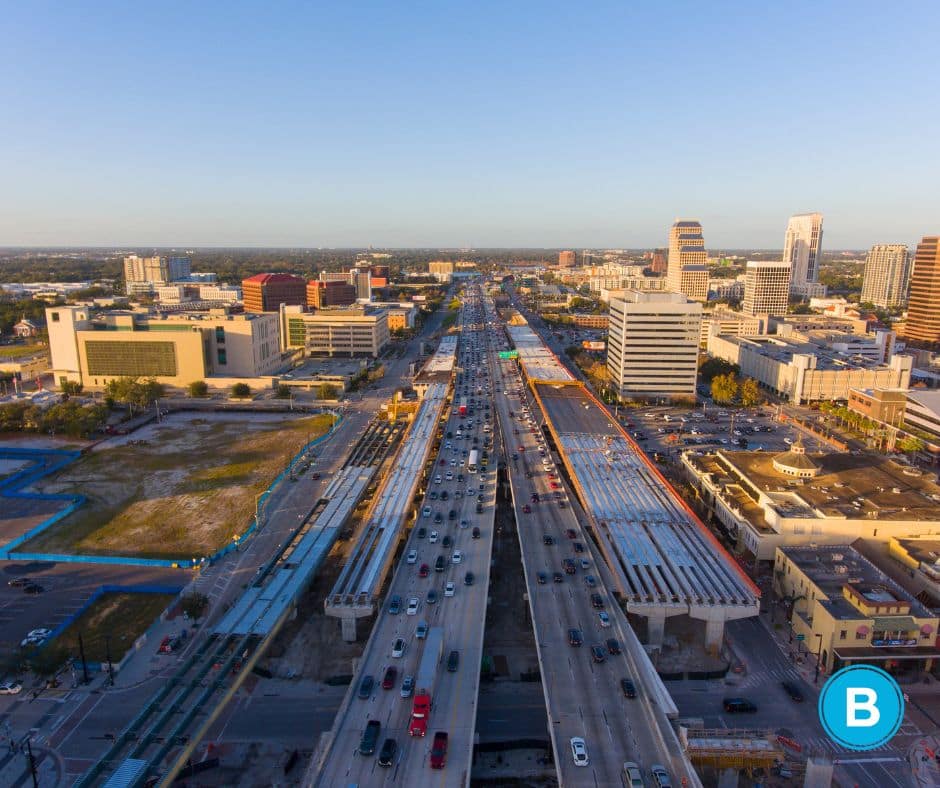
If you’ve lived in Central Florida for any length of time, chances are you’ve driven on Interstate 4. I-4 is a major thoroughfare of the Sunshine State, spanning 132 miles from Daytona Beach to the Interstate 275 interchange in Tampa. The highway runs right through the heart of Orlando, making it a huge part of tourism in Florida. Because of its extensive use and importance to the economy and local commuters, traffic authorities deemed expansion a necessity because of traffic increases over the last few years.
The “I-4 Ultimate” is a six-year reconstruction plan to widen Interstate 4 and (hopefully) decrease the bothersome traffic that it’s known for. The plan will allow smoother travel for the area’s over 200,000 daily motorists that travel the interstate. This amount of traffic is why I-4’s new rating as the most deadly highway in America isn’t a surprise.
Why is Interstate 4 so dangerous?
According to studies put on by insurance companies, Florida is the second-most dangerous state to drive through in the nation. Topped only by California, Florida sees an average of over 19 fatal crashes per 100 miles each year.
Understanding what part of Florida is most deadly is important if you live here. The same studies show that Interstate 4 is the deadliest highway across the board. Not only is it the most dangerous in Florida, but statistically is the deadliest in the entire country. On average, 34 fatal crashes happen on its 132-mile stretch annually.
Why?
The huge amount of traffic is the culprit. In addition to its points of origin, Daytona Beach and Tampa, Interstate 4 runs alongside many major attractions in the state of Florida including:
- Walt Disney World
- Universal Studios
- multiple water parks
- SeaWorld
- Legoland Florida
- Orlando Eye
- Amway Arena
- Kia Center
- Camping World Stadium
- and MORE
Visiting any of these popular spots requires driving on Interstate 4 if you’re following a standard GPS. All those places to visit means a LOT of people on the road.
How can I protect myself on Interstate 4?
Obviously, there is no hard and fast rule for protecting yourself on any highway. Accidents can and do happen, but you should take precautions to avoid them whenever possible. So, our team of experienced accident attorneys weighed in, and here’s what they said about driving safely on I-4.
Avoid busy times.

Interstate 4 never sleeps!
Like any highway, I-4 has its fair share of “rush hour” traffic. There is never really a “down” time when going through the Orlando area, but you can avoid the worst of traffic by choosing your driving time wisely. Aim for a very early commute, or opt for later work hours and head home when some of the traffic has cleared.
Use alternate routes.
Many roads in the Tampa Bay area parallel or circumnavigate Interstate 4. The Florida Department of Transportation (DOT) recommends using these if driving has become a hardship during the reconstruction project. They suggest:
State Road 417 (the Central Florida Greenway)
This toll road takes you around Orlando entirely, avoiding both I-4 and the Florida Turnpike.
State Road 436 to State Road 429 (the Western Beltway)
Another toll road, this route reroutes you through Apopka, going around some of the worst of the Orlando traffic.
Other favorites of locals include US 301 North in Tampa to State Road 50 near Orlando. This is a good option for commuters who travel between the two cities for work each day. State Road 92 is another popular choice as it closely parallels the major interstate.
Use transportations services.
Central Florida has a long list of transportation options that are good for the environment, and good for your mental health if traffic stresses you out! In addition to SunRail and CitrusConnection, the DOT has others listed on their site for consideration.
Practice basic safety protocols.
It’s no secret that driving in traffic is stressful, and oftentimes dangerous. Remembering safe driving rules from Drivers Education matters most in these situations. Don’t tailgate, follow the speed limit (especially important in work zones!), minimize distractions, and drive defensively. If you’re ready for anything when behind the wheel, you’ll be better prepared to react and avoid a collision if something goes wrong.
Brooks Law Group knows I-4 all too well.
As some of Tampa Bay’s top attorneys, the team at Brooks Law Group knows all too well the dangers of Interstate 4. Not only do many of our lawyers and staff travel this road each day, but we see countless clients impacted by its risks. We’re glad for the changes occurring and hope the widening of I-4 will alleviate some of these longstanding issues.
Have you or someone you love been affected by an accident on Interstate 4? We’re here to help. Brooks Law Group fights for the justice and compensation you deserve following the actions of a negligent or reckless driver. Call us to schedule your free consultation and let us focus on your case so you can focus on healing. When accidents happen, you can always Look to Brooks.













